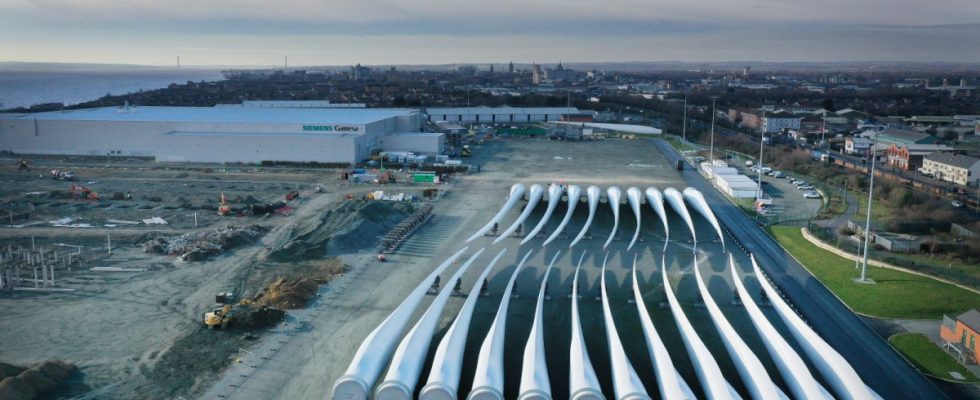Getting used to bad news over time certainly doesn’t bode well. This also and especially applies to company news. And recently especially for: the energy technology supplier Siemens Energy. The company, which was spun off from the Siemens group three years ago, has been keeping its shareholders busy for the past three years with regular profit warnings – and whenever the last one has just been digested, the next one comes along.
This Monday, however, the group eclipsed everything: In the past quarter, the company made a record loss of around three billion euros – at the end of the year there could be much higher losses. As soon as the news was out, the Siemens Energy share, which is listed in the Dax, fell by a whopping seven percent in the morning, then rose again slightly, then fell again. A rollercoaster ride that probably means nothing else than: At Siemens Energy there are not only new and worse surprises all the time – in the end you don’t even know exactly what to think of it all anymore. “The cat is now out of the bag,” a stock trader was quoted as saying.
The cat has to be out of the bag – not that easy
In order to understand how the cat got into the sack in the first place, you have to explain this corporation briefly. Basically, Siemens Energy consists of two parts. On the one hand there is the classic, traditional electricity business. Energy transmission, power grids, power plant construction, the business with fossil fuels, i.e. what has always been done. On the other hand, the future business with wind energy and turbines on land and on the high seas. The deal with the subsidiary Siemens Gamesa. The old energy technology business is just making money, the future business with wind energy is a disaster – that has been the drama of Siemens Energy for a long time.
Siemens Gamesa was formed in spring 2017 following the purchase and merger with Siemens’ own wind energy division. Actually an investment in the future, the old tanker Siemens had arrived in the middle of the energy transition. At least that’s what you thought. But then came the problems. And they kept getting bigger, quarter by quarter. Sometimes technical problems, sometimes cost problems, sometimes all at the same time.
It had been clear for weeks that the cat would eventually have to come out of the bag, and completely. Behind the scenes, the group’s problems were getting worse and worse, more and more serious quality defects in the wind turbines, more and more hidden problems. As early as June, the Munich company had warned that things would get much worse for the German-Spanish wind energy subsidiary. At that time, Siemens Energy shares had plummeted like never before.
Last Friday, the group’s supervisory board came together, pulled the ripcord – and drew a line under the bill: red numbers, probably around 4.5 billion euros for this year in total. It is a gigantic debacle, of all things, in the wind turbine business, of all things, when it comes to the future topic of energy transition.
Problems after problems, so here are just a few of them: It will cost around 1.6 billion euros to repair damage to rotor blades and bearings on wind turbine platforms that are on land, the company said. The turbines can fail more often because of the technical defects; the repairs are scheduled to take place between 2024 and 2025. Siemens Energy expects exploding material and procurement costs for wind turbines at sea to amount to 600 million euros. And: The deals are often loss-making because fixed prices were agreed a long time ago for long-term projects. But then the cost of energy, steel and semiconductors increased. And old bills and calculations suddenly no longer worked out.
“Due to the developments at Siemens Gamesa, we are reviewing the current strategy and action plan in the wind business,” the company said in a statement. Details of the strategic plan are then to be announced at the Capital Markets Day in November. The cat is out of the bag – but only a little bit.
CEO Christian Bruch now wants to review strategies and measures – that sounds good at first. However, its wind energy subsidiary Gamesa has had major problems for years.
(Photo: Andreas Pohlmann/Siemens AG)
Because what does that mean for the Siemens Energy business with wind turbines? And what does it mean when strategies and measures are now being reviewed? Wouldn’t that have been indicated a long time ago? So everything is open, as I said, people at Siemens Energy have gotten used to bad news.
The game with time
It wasn’t that long ago that management promised better times. This is one of the reasons why the company took over its wind power subsidiary, in which it only had a stake for a long time, for four billion euros. Do you now recognize problems faster and better when a company like Siemens Gamesa is 100 percent owned? For a long time, many have been wondering why the big problems hadn’t been noticed before. Were the technical problems really that invisible? Is it because there was and is not enough communication between the parent company in Germany and the Spanish subsidiary Gamesa? Were things swept under the carpet that should have been on the table? If problems keep cropping up on a quarterly basis and tend to get bigger rather than smaller, that’s not a good sign.
Until recently, CEO Bruch had set the goal of making profits again in the coming year. Now it will only be clarified in November whether it will really be possible to comply with this. Many questions, and by no means all of them have been answered: there are still a few months until November, and the group, it’s obvious, wants to gain time first.

